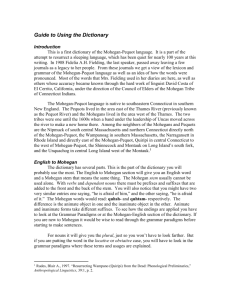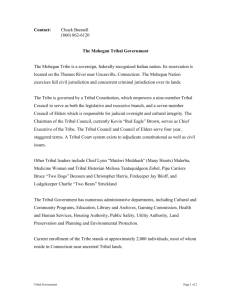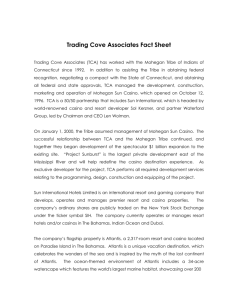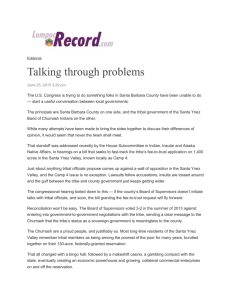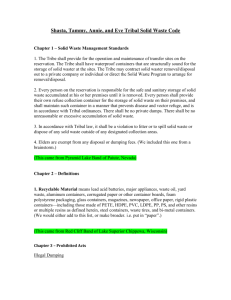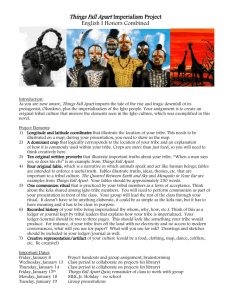DOC - The Mohegan Tribe
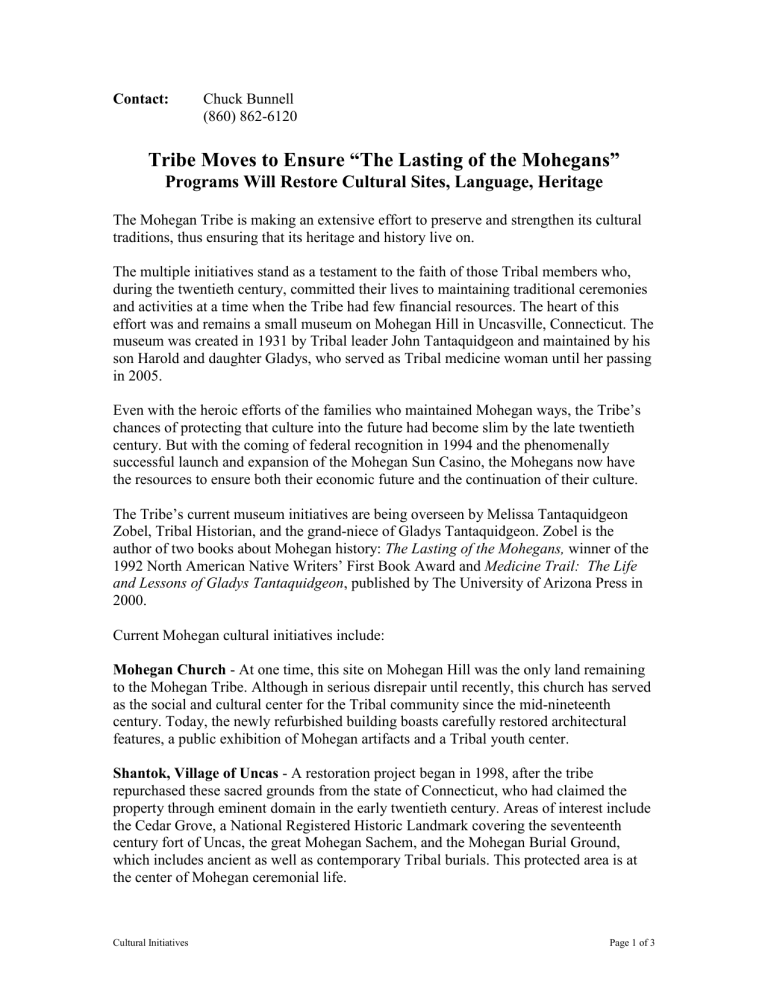
Contact: Chuck Bunnell
(860) 862-6120
Tribe Moves to Ensure “The Lasting of the Mohegans”
Programs Will Restore Cultural Sites, Language, Heritage
The Mohegan Tribe is making an extensive effort to preserve and strengthen its cultural traditions, thus ensuring that its heritage and history live on.
The multiple initiatives stand as a testament to the faith of those Tribal members who, during the twentieth century, committed their lives to maintaining traditional ceremonies and activities at a time when the Tribe had few financial resources. The heart of this effort was and remains a small museum on Mohegan Hill in Uncasville, Connecticut. The museum was created in 1931 by Tribal leader John Tantaquidgeon and maintained by his son Harold and daughter Gladys, who served as Tribal medicine woman until her passing in 2005.
Even with the heroic efforts of the families who maintained Mohegan ways, the Tribe’s chances of protecting that culture into the future had become slim by the late twentieth century. But with the coming of federal recognition in 1994 and the phenomenally successful launch and expansion of the Mohegan Sun Casino, the Mohegans now have the resources to ensure both their economic future and the continuation of their culture.
The Tribe’s current museum initiatives are being overseen by Melissa Tantaquidgeon
Zobel, Tribal Historian, and the grand-niece of Gladys Tantaquidgeon. Zobel is the author of two books about Mohegan history: The Lasting of the Mohegans, winner of the
1992 North American Native Writers’ First Book Award and Medicine Trail: The Life and Lessons of Gladys Tantaquidgeon , published by The University of Arizona Press in
2000.
Current Mohegan cultural initiatives include:
Mohegan Church - At one time, this site on Mohegan Hill was the only land remaining to the Mohegan Tribe. Although in serious disrepair until recently, this church has served as the social and cultural center for the Tribal community since the mid-nineteenth century. Today, the newly refurbished building boasts carefully restored architectural features, a public exhibition of Mohegan artifacts and a Tribal youth center.
Shantok, Village of Uncas - A restoration project began in 1998, after the tribe repurchased these sacred grounds from the state of Connecticut, who had claimed the property through eminent domain in the early twentieth century. Areas of interest include the Cedar Grove, a National Registered Historic Landmark covering the seventeenth century fort of Uncas, the great Mohegan Sachem, and the Mohegan Burial Ground, which includes ancient as well as contemporary Tribal burials. This protected area is at the center of Mohegan ceremonial life.
Cultural Initiatives Page 1 of 3
Royal Mohegan Burial Ground - In Norwich, a nearby city, a project is underway to restore the site of an extensive Mohegan burial ground desecrated by heartless construction in 1842. Those interred at this site include members of the family of Uncas, the famous Mohegan Sachem mythologized in James Fenimore Cooper’s
Last of the
Mohicans.
Archeological Field School & Contemporary Indian Issues Class – The Tribe has created a summer archaeological school and winter class on contemporary Native
American issues in conjunction with nearby Eastern Connecticut State University.
Teachers include prominent Native American scholars and other Indian professionals.
The Mohegan Language Restoration Project - The last fluent speaker of the Mohegan tongue died in the early twentieth century. At that time, many parents had stopped teaching the language to their children, for fear of retribution by teachers in local schools.
An extensive project is now underway to restore the language and begin teaching it to all interested Tribal members. The project based on a study of the language by anthropologist Frank Speck almost a century ago, includes the creation of instructional videos, tapes and books.
Secret Guide - This guidebook explains the Mohegan cultural roots of the Tribal designs featured in Mohegan Sun’s casino, hotel and shops.
School Curriculum - The Tribe produced “The Mark of Uncas,” a one-hour documentary on the famous seventeenth century Mohegan leader. An educational curriculum for grades 7-college is available that may be used in conjunction with the documentary.
Read Magazine – In 2003, the Mohegan Tribe sponsored an issue of Weekly Reader’s
Read Magazine . Included were traditional Tribal children’s stories and an original play about the life of Uncas, the great Mohegan Chief who befriended the English in the seventeenth century.
Intern Program - Each year, several Mohegan college students train in oral history, hands-on artifact research and other forms of traditional knowledge.
Gatherings - Known in Mohegan as KIDUSOWANG (Readers Gathering) and
YUTIMICUWANG (Food for Thought), members assemble to discuss contemporary
Native American literature and historic themes.
High School Celebration - Graduating high school seniors are treated to a coming of age event following weeks of intensive study and training in topics affecting today’s Native
American young adults.
School Outreach Programs - Local schools benefit from free presentations on Mohegan dance, drumming, history and storytelling.
Cultural Initiatives Page 2 of 3
Summer Camp - Tribal children gather each summer to participate in both contemporary and “heritage” activities.
Wigwam - Each August, the Tribe sponsors a free “pow wow” style event to celebrate the annual Green Corn Festival or Thanksgiving for the Corn Harvest. Here, the general public is invited to view dance competitions, musical performances, art shows and other special events.
Arts & Crafts - Many ancient arts and crafts from splint basket making to wampum production are currently being revived by Tribal members.
National Museum of the American Indian - The Mohegan Tribe donated $10 million for the development of the Smithsonian’s National Museum of the American Indian, which opened in 2004. “Our commitment to the preservation and restoration of Native
American culture extends beyond that of our own tribe,” said Mark Brown, Former
Chairman of the Mohegan Tribal Council. “We are proud that we have the resources to help all tribes retain their heritage and traditions.”
Cultural Initiatives Page 3 of 3

